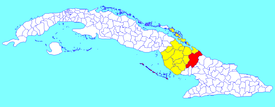Guáimaro
Appearance
Guáimaro | |
|---|---|
 Guáimaro municipality (red) within Camagüey Province (yellow) and Cuba | |
| Lua error in Module:Location_map at line 526: Unable to find the specified location map definition: "Module:Location map/data/Cuba1" does not exist. | |
| Coordinates: 21°03′32″N 77°20′52″W / 21.05889°N 77.34778°W | |
| Country | |
| Province | Camagüey |
| Established | 1924[1] |
| Area | |
| • Total | 1,847 km2 (713 sq mi) |
| Elevation | 80 m (260 ft) |
| Population (2004)[3] | |
| • Total | 57,086 |
| • Density | 30.9/km2 (80/sq mi) |
| Time zone | UTC-5 (EST) |
| Area code | +53-322 |
| Climate | Aw |
Guáimaro is a town and municipality in the southern part of Camagüey Province in Cuba. It is located between the cities of Camagüey and Las Tunas.
History
Guáimaro features prominently in Cuban history as the place where in 1869 the Revolutionary Army of Mambises met and created the Constitution for a new nation free from Spanish colonial oppression. The municipality was created in 1943, when it split from Camagüey.
Geography
The municipality is divided into the barrios of Camaniguán, Elia, Galbis, Guáimaro, Palo Seco, Pilar and Tetuán.[1]
Demographics
In 2004, the municipality of Guáimaro had a population of 57,086.[3] With a total area of 1,847 km2 (713 sq mi),[2] it has a population density of 30.9/km2 (80/sq mi).
See also
References
- ^ a b Guije.com. "Guáimaro" (in Spanish). Retrieved 2007-10-05.
- ^ a b Statoids. "Municipios of Cuba". Retrieved 2007-10-05.
- ^ a b Atenas.cu (2004). "2004 Population trends, by Province and Municipality" (in Spanish). Archived from the original on 2007-09-27. Retrieved 2007-10-05.
External links
Wikimedia Commons has media related to Guáimaro.
